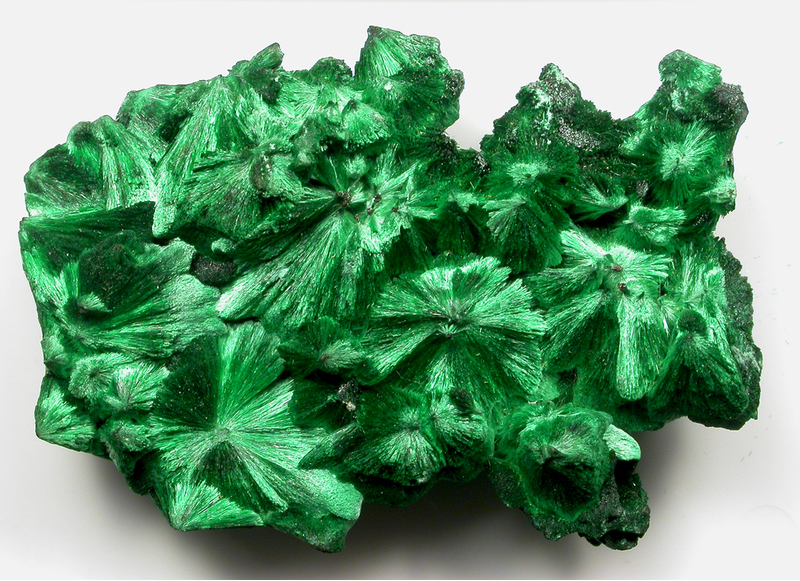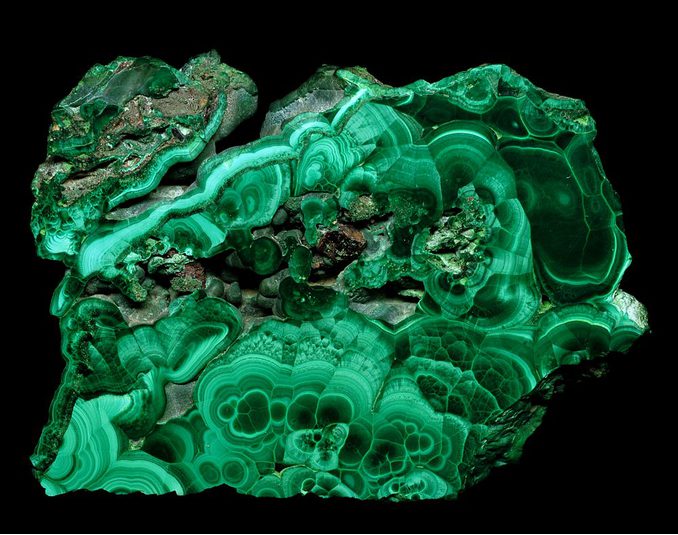Malachite (original) (raw)
A valid IMA mineral species - grandfathered
About MalachiteHide
This section is currently hidden. Click the show button to view.
Colour:
Bright green, with crystals deeper shades of green, even very dark to nearly black; green to yellowish green in transmitted light.
Specific Gravity:
3.6 - 4.05
Crystal System:
Monoclinic
Name:
Named "molochitus" in antiquity (see Pliny the Elder, 79 CE) after the Greek μαλαχή ("malachí"), "mallows," in allusion to the green colour of the leaves. Known in the new spelling, "malachites", at least by 1661.
Malachite is a green, very common secondary copper mineral with a widely variable habit. Typically, it is found as crystalline aggregates or crusts, often banded in appearance, like agates. It is also frequently found as botryoidal clusters of radiating crystals, and as mammillary aggregates as well. Single crystals and clusters of distinguishable crystals are uncommon, but when found they are typically acicular to prismatic. It is also frequently found as a pseudomorph after azurite crystals, which are generally more tabular.
The Cu analogue of chukanovite. Structurally related to the Rosasite Group.
Unique IdentifiersHide
This section is currently hidden. Click the show button to view.
Long-form identifier:
mindat:1:1:2550:4
18524637-6bf6-4633-a2e3-6f4928b0251d
IMA Classification of MalachiteHide
This section is currently hidden. Click the show button to view.
Approved, 'Grandfathered' (first described prior to 1959)
Classification of MalachiteHide
This section is currently hidden. Click the show button to view.
5.BA.10
5 : CARBONATES (NITRATES)
B : Carbonates with additional anions, without H2O
A : With Cu, Co, Ni, Zn, Mg, Mn
16a.3.1.1
16a : ANHYDROUS CARBONATES CONTAINING HYDROXYL OR HALOGEN
3 : (AB)2(XO3)Zq
11.2.1
11 : Carbonates
2 : Carbonates of Cu
Mineral SymbolsHide
This section is currently hidden. Click the show button to view.
As of 2021 there are now IMA–CNMNC approved mineral symbols (abbreviations) for each mineral species, useful for tables and diagrams.
Please only use the official IMA–CNMNC symbol. Older variants are listed for historical use only.
| Symbol | Source | Reference |
|---|---|---|
| Mlc | IMA–CNMNC | Warr, L.N. (2021). IMA–CNMNC approved mineral symbols. Mineralogical Magazine, 85(3), 291-320. doi:10.1180/mgm.2021.43 |
| Mlc | Whitney & Evans (2010) | Whitney, D.L. and Evans, B.W. (2010) Abbreviations for names of rock-forming minerals. American Mineralogist, 95, 185–187 doi:10.2138/am.2010.3371 |
| Mal | The Canadian Mineralogist (2019) | The Canadian Mineralogist (2019) The Canadian Mineralogist list of symbols for rock- and ore-forming minerals (December 30, 2019). download |
Physical Properties of MalachiteHide
This section is currently hidden. Click the show button to view.
Colour:
Bright green, with crystals deeper shades of green, even very dark to nearly black; green to yellowish green in transmitted light.
Cleavage:
Perfect
Perfect on {201}, fair on {010}.
Density:
3.6 - 4.05 g/cm3 (Measured) 4 g/cm3 (Calculated)
Optical Data of MalachiteHide
This section is currently hidden. Click the show button to view.
RI values:
_n_α = 1.655 _n_β = 1.875 _n_γ = 1.909
2V:
Measured: 43° , Calculated: 38°
δ = 0.254
Image shows birefringence interference colour range (at 30µm thickness)
and does not take into account mineral colouration.
Dispersion:
relatively weak
Optical Extinction:
Y = b; X ∧ c = 23.5°.
Comments:
X = nearly colorless; Y = yellowish green; Z = deep green.
Chemistry of MalachiteHide
This section is currently hidden. Click the show button to view.
Mindat Formula:
Cu2(CO3)(OH)2
Common Impurities:
Zn,Co,Ni
Crystallography of MalachiteHide
This section is currently hidden. Click the show button to view.
Crystal System:
Monoclinic
Class (H-M):
2/m - Prismatic
Cell Parameters:
a = 9.502 Å, b = 11.974 Å, c = 3.240 Å
β = 98.75°
Ratio:
a:b:c = 0.794 : 1 : 0.271
Unit Cell V:
364.35 ų (Calculated from Unit Cell)
Morphology:
Crystals uncommon, usually short or long prismatic or acicular, parallel to [001]; often grouped in rosettes, sprays, or tufts. Botryoidal to mammillary aggregates of radiating fibrous crystals more common. It may also be massive, compact, and stalactitic.
Twinning:
Untwinned crystals are extremely rare. Typically twinned on {100}, sometimes as penetration or polysynthetic twinning with the axis parallel to [201].
Crystallographic forms of MalachiteHide
This section is currently hidden. Click the show button to view.
Crystal Atlas:
Image Loading
3d models and HTML5 code kindly provided bywww.smorf.nl.
Toggle
Edge Lines |Miller Indices |Axes
Transparency
Opaque |Translucent |Transparent
View
Along a-axis |Along b-axis |Along c-axis |Start rotation |Stop rotation
Crystal StructureHide
This section is currently hidden. Click the show button to view.
Load
Unit Cell |Unit Cell Packed
2x2x2 |3x3x3 |4x4x4
Show
Big Balls |Small Balls |Just Balls |Spacefill
Polyhedra Off |Si Polyhedra |All Polyhedra
Remove metal-metal sticks
Display Options
Black Background |White Background
Perspective On |Perspective Off
2D |Stereo |Red-Blue |Red-Cyan
View
CIF File Best |x |y |z |a |b |c
Rotation
Stop |Start
Labels
Console Off |On |Grey |Yellow
| ID | Species | Reference | Link | Year | Locality | Pressure (GPa) | Temp (K) |
|---|---|---|---|---|---|---|---|
| 0009305 | Malachite | Susse P (1967) Verfeinerung der kristallstruktur des malachits, Cu2(OH)2CO3 Acta Crystallographica 22 146-151 |  |
1967 | 0 | 293 | |
| 0010795 | Malachite | Zigan F, Joswig W, Schuster H U, Mason S A (1977) Verfeinerung der Struktur von Malachit, Cu2(OH)2CO3, durch Neutronenbeugung Zeitschrift fur Kristallographie 145 412-426 | 1977 | 0 | 293 |
CIF Raw Data - click here to close
X-Ray Powder DiffractionHide
This section is currently hidden. Click the show button to view.
Image Loading
Radiation - Copper Kα
Data Set:
Data courtesy of RRUFF project at University of Arizona, used with permission.
Powder Diffraction Data:
| d-spacing | Intensity |
|---|---|
| 5.99 Å | (60) |
| 5.06 Å | (80) |
| 3.69 Å | (90) |
| 2.86 Å | (100) |
| 2.82 Å | (40) |
| 2.78 Å | (50) |
| 2.52 Å | (60) |
| 2.46 Å | (40) |
Comments:
Data given are for synthetic material.
Geological EnvironmentHide
This section is currently hidden. Click the show button to view.
Geological Setting:
It is the most common secondary mineral found in the oxidized zones of copper deposits.
Synonyms of MalachiteHide
This section is currently hidden. Click the show button to view.
Other Language Names for MalachiteHide
This section is currently hidden. Click the show button to view.
Simplified Chinese:孔雀石
Traditional Chinese:孔雀石
Varieties of MalachiteHide
This section is currently hidden. Click the show button to view.
| Atlaserz | The German name for a fibrous variety of malachite. |
|---|---|
| Lime-Malachite | Probably an impure calcium-bearing malachite. |
| Mysorin | An impure Malachite. |
| Zinc-bearing Malachite | A Zn-bearing variety of malachite with Cu:Zn greater than 4:1.Can be distinguished from the visually similar rosasite by X-ray diffraction. |
Relationship of Malachite to other SpeciesHide
This section is currently hidden. Click the show button to view.
Other Members of this group:
Common AssociatesHide
This section is currently hidden. Click the show button to view.
Associated Minerals Based on Photo Data:
Related Minerals - Strunz-mindat GroupingHide
This section is currently hidden. Click the show button to view.
Other InformationHide
This section is currently hidden. Click the show button to view.
Thermal Behaviour:
Loses water at about 315°, leaving tenorite.
Notes:
Readily soluble in dilute acids. Very slightly soluble in water containing CO2.
Frequently found as pseudomorphs after azurite, or as alteration pseudomorphs after cuprite. Less frequently occurs as pseudomorphs after atacamite, brochantite, chalcopyrite, tetrahedrite, chalcophyllite, gypsum, libethenite, calcite, sphalerite, cerussite, and pyrite.
Rarely found altered to azurite or cuprite.
Health Risks:
No information on health risks for this material has been entered into the database. You should always treat mineral specimens with care.
Industrial Uses:
A minor ore of copper when abundant enough in a copper deposit.
Malachite in petrologyHide
This section is currently hidden. Click the show button to view.
Internet Links for MalachiteHide
This section is currently hidden. Click the show button to view.
References for MalachiteHide
This section is currently hidden. Click the show button to view.
Reference List:
Zigan, F., Joswig, W., Schuster, H. D., Mason, S. A. (1977) Verfeinerung der Struktur von Malachit, Cu2(OH)2CO3, durch Neutronenbeugung. Zeitschrift für Kristallographie - Crystalline Materials, 145 (5-6) 412 doi:10.1524/zkri.1977.145.5-6.412
Frost, R. L., Martens, W. N., Rintoul, L., Mahmutagic, E., Kloprogge, J. T. (2002) Raman spectroscopic study of azurite and malachite at 298 and 77 K. Journal of Raman Spectroscopy, 33 (4). 252-259 doi:10.1002/jrs.848
Significant localities for MalachiteHide
This section is currently hidden. Click the show button to view.
Showing 23 significant localities out of 14,755 recorded on mindat.org.
This map shows a selection of localities that have latitude and longitude coordinates recorded. Click on the  symbol to view information about a locality. The
symbol to view information about a locality. The  symbol next to localities in the list can be used to jump to that position on the map.
symbol next to localities in the list can be used to jump to that position on the map.
Locality ListHide
This section is currently hidden. Click the show button to view.
 - This locality has map coordinates listed.
- This locality has map coordinates listed.  - This locality has estimated coordinates. ⓘ - Click for references and further information on this occurrence. ? - Indicates mineral may be doubtful at this locality.
- This locality has estimated coordinates. ⓘ - Click for references and further information on this occurrence. ? - Indicates mineral may be doubtful at this locality.  - Good crystals or important locality for species.
- Good crystals or important locality for species.  - World class for species or very significant. (TL) - Type Locality for a valid mineral species. (FRL) - First Recorded Locality for everything else (eg varieties).
- World class for species or very significant. (TL) - Type Locality for a valid mineral species. (FRL) - First Recorded Locality for everything else (eg varieties). Struck out - Mineral was erroneously reported from this locality. Faded * - Never found at this locality but inferred to have existed at some point in the past (e.g. from pseudomorphs).
All localities listed without proper references should be considered as questionable.

